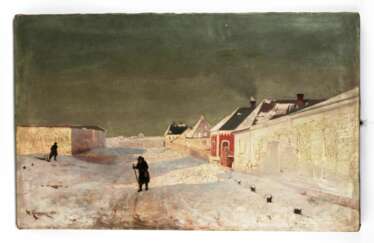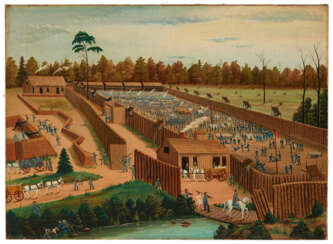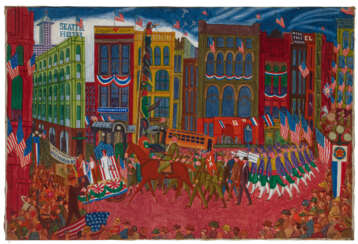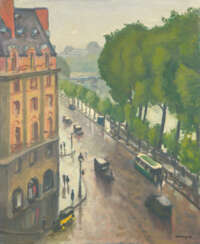картина город



Gherardo Poli was an Italian Baroque painter who specialised in townscapes and genre scenes.


Michele Marieschi was an Italian painter, known for his landscape and cityscape paintings, primarily of Venice. Born in 1696, Marieschi was a pivotal figure in the veduta genre, a style focusing on detailed and often idealized representations of cityscapes. His works are celebrated for their architectural detail and the lively, fresh use of paint, distinguishing him from his contemporaries like Canaletto. Michele Marieschi's paintings often featured exaggerated perspectives, infusing scenes from life with the novelty of capricious invention.
His career included a significant period from 1735 to 1741 when he was registered with the Venetian painters' guild, indicating his recognition and establishment within the Venetian art community. In 1741, Marieschi published a set of 21 prints of Venice, providing a lasting legacy of his perspective on the city's unique landscape. This collection, titled "Magnificentiores Selectioresque Urbis Venetiarum Prospectus," included a self-portrait, underscoring his role in documenting Venice's architectural splendor.
Michele Marieschi's approach to vedute was influenced by his early work in scenery painting, allowing him to create urban views marked by an inventive use of perspective. This stylistic choice offered a new dimension to scenes taken from life, setting Marieschi apart from his peers.
For collectors and experts in art and antiques, Michele Marieschi's works represent a unique blend of architectural precision and imaginative composition. His influence on later painters, including Francesco Guardi, underscores his importance in the development of the veduta genre.
To stay informed about new discoveries, sales, and auction events related to Michele Marieschi's work, signing up for updates from relevant art institutions and auction houses is recommended. This subscription ensures that enthusiasts and collectors remain abreast of the latest developments related to this master of the Italian cityscape.


Edward Brian Seago was an English artist who painted in both oils and watercolours.


Edward Brian Seago was an English artist who painted in both oils and watercolours.


Francis Wheatley was a British painter and illustrator, a Fellow of the Royal Academy of Arts.
He successfully studied at the Royal Academy of Arts, but was soon forced to flee to Ireland, where he established himself as a portrait painter and created one of his most famous works, "The Irish House of Commons". Wheatley also painted genre scenes from rural life, landscapes. Later, back in England, Wheatley collaborated with print publisher John Boydell and created works for the Shakespeare Gallery that were later engraved, and it was his illustrations of novels and various genre subjects that formed Wheatley's enduring reputation as a talented illustrator.
In 1791 Wheatley was elected a full member (Academician) of the Royal Academy of Arts.
Today, Francis Wheatley is best known for his two portraits of Admiral Arthur Phillip, the founder of the permanent British settlements in Australia, which today always illustrate the history of the exploration of the Australian continent.


Victor Gabriel Gilbert was a French painter mostly known for his Parisian scenes and portraying market scenes there. He studied with Victor Adam (1801-1866) and subsequently with Charles Busson (1822-1908). In 1889 he was awarded a silver medal in the Société des Artistes Français, and a Bonnat prize in 1926 at the end of his career.


Hendrick Mommers was a Dutch Golden Age landscape painter.


Guy Carleton Wiggins was an American artist known for his impressionistic winter landscapes, particularly those of New York City.
Wiggins began his artistic training at a young age and went on to study at the National Academy of Design and the Art Students League in New York City. He also studied in Europe, particularly in France, where he was heavily influenced by the Impressionist movement.
Wiggins is best known for his snowscapes, which often depict New York City streets, parks, and landmarks covered in snow. He used a technique of laying thick, impasto paint on the canvas, creating a sense of depth and texture in his paintings.
Wiggins was a prolific artist, producing over 3,000 works during his lifetime. He was a member of several art organizations, including the Salmagundi Club, the National Academy of Design, and the American Watercolor Society.
Today, his paintings can be found in numerous private and public collections, including the Metropolitan Museum of Art, the Smithsonian American Art Museum, and the White House.


Guy Carleton Wiggins was an American artist known for his impressionistic winter landscapes, particularly those of New York City.
Wiggins began his artistic training at a young age and went on to study at the National Academy of Design and the Art Students League in New York City. He also studied in Europe, particularly in France, where he was heavily influenced by the Impressionist movement.
Wiggins is best known for his snowscapes, which often depict New York City streets, parks, and landmarks covered in snow. He used a technique of laying thick, impasto paint on the canvas, creating a sense of depth and texture in his paintings.
Wiggins was a prolific artist, producing over 3,000 works during his lifetime. He was a member of several art organizations, including the Salmagundi Club, the National Academy of Design, and the American Watercolor Society.
Today, his paintings can be found in numerous private and public collections, including the Metropolitan Museum of Art, the Smithsonian American Art Museum, and the White House.


Guy Carleton Wiggins was an American artist known for his impressionistic winter landscapes, particularly those of New York City.
Wiggins began his artistic training at a young age and went on to study at the National Academy of Design and the Art Students League in New York City. He also studied in Europe, particularly in France, where he was heavily influenced by the Impressionist movement.
Wiggins is best known for his snowscapes, which often depict New York City streets, parks, and landmarks covered in snow. He used a technique of laying thick, impasto paint on the canvas, creating a sense of depth and texture in his paintings.
Wiggins was a prolific artist, producing over 3,000 works during his lifetime. He was a member of several art organizations, including the Salmagundi Club, the National Academy of Design, and the American Watercolor Society.
Today, his paintings can be found in numerous private and public collections, including the Metropolitan Museum of Art, the Smithsonian American Art Museum, and the White House.


Guy Carleton Wiggins was an American artist known for his impressionistic winter landscapes, particularly those of New York City.
Wiggins began his artistic training at a young age and went on to study at the National Academy of Design and the Art Students League in New York City. He also studied in Europe, particularly in France, where he was heavily influenced by the Impressionist movement.
Wiggins is best known for his snowscapes, which often depict New York City streets, parks, and landmarks covered in snow. He used a technique of laying thick, impasto paint on the canvas, creating a sense of depth and texture in his paintings.
Wiggins was a prolific artist, producing over 3,000 works during his lifetime. He was a member of several art organizations, including the Salmagundi Club, the National Academy of Design, and the American Watercolor Society.
Today, his paintings can be found in numerous private and public collections, including the Metropolitan Museum of Art, the Smithsonian American Art Museum, and the White House.


Alfred Sisley was a Franco-British painter, celebrated as a key figure in the Impressionist movement. Born in Paris to British parents, Sisley dedicated his artistic career to capturing the tranquil landscapes of his adopted France, particularly the areas around Paris and Moret-sur-Loing, where he spent his later years.
From the beginning, Alfred Sisley was a devoted landscape artist, preferring to work en plein air to capture the subtle shifts in the atmosphere and light of his surroundings. Unlike some of his contemporaries who explored urban scenes or human figures, Sisley's works predominantly feature rural settings, quiet streets, and serene river scenes, often devoid of people. His approach was deeply influenced by earlier landscape painters like Jean-Baptiste-Camille Corot, yet his style embodies the quintessential Impressionist focus on light and color.
Despite his dedication and prolific output, Alfred Sisley's work did not gain significant recognition or financial success during his lifetime. It was only posthumously that his paintings began to receive the acclaim they deserved, with his canvases now held in prestigious collections worldwide, including the Musée d'Orsay and the National Gallery.
For collectors and experts in art and antiques, Alfred Sisley's works represent a poignant chapter in the history of Impressionism, characterized by a gentle yet profound rendering of the natural world. His paintings not only reflect the beauty of the French countryside but also encapsulate the fleeting moments of light and weather, making them timeless masterpieces of Impressionist art.
For those interested in the serene beauty of Alfred Sisley's landscapes and updates on exhibitions or sales of his works, signing up for specialized newsletters can provide invaluable insights and opportunities.


Albert Marquet was a French painter, renowned for his affiliation with the Fauvist movement, a group characterized by their use of wild, vivid colors to depict emotional expression. Unlike his contemporaries who embraced bright and violent colors, Marquet distinguished himself with a more subdued palette, employing less intense tones by mixing complementary colors to achieve a naturalistic style, primarily in landscapes. His work is celebrated for its simplicity in form and color, often focusing on serene water scenes, bustling city views, and the animated life of waterfront cities, particularly in North Africa and across various European locales like Naples and Venice.
Marquet's technique involved painting water as a broad area of simple tone, which cleverly held the plane of the water's surface without resorting to illusionistic perspective, allowing ships to emerge into a different plane with ease. This method, alongside his unique approach to color and composition, drew parallels with Japanese Shijo style work, emphasizing simplicity, movement, and the effective use of color to capture scenes' essence.
Throughout his career, Marquet frequently returned to favored subjects, capturing subtle variations in light and atmosphere. His landscapes, cityscapes, and maritime scenes are noted for their tranquility and the artist's keen observation of light and color. His works are housed in prestigious museums worldwide, including the Musée National d'Art Moderne, the Metropolitan Museum of Art, and the Pushkin Museum, showcasing his versatile talent in capturing the natural and urban environment.
Marquet's legacy is significant, admired for his astute sense of color and the ability to convey atmospheric mood with minimal elements. His influence extends beyond the canvas, impacting subsequent generations of artists and collectors who appreciate the subtlety and depth of his work. For collectors and experts in art and antiques, Albert Marquet represents a pivotal figure in modern art, whose works continue to inspire and captivate audiences with their serene beauty and emotional depth.
To stay informed about new sales and auction events related to Albert Marquet's works, signing up for updates can offer exclusive insights and opportunities to acquire pieces by this influential artist. This subscription is an invaluable resource for those keen to enhance their collection with works by one of the masters of Fauvism and modern landscape painting.


Johan Barthold Jongkind was a Dutch painter and printmaker. He painted marine landscapes in a free manner and is regarded as a forerunner of Impressionism.
Jongkind's most frequent subject was the marine landscape, which he painted both in the Netherlands and in France. Many of his works depict the Seine, particularly the area near Notre-Dame Cathedral. He painted watercolors out-of-doors, and used them as sketches for oil paintings made in his studio. His paintings are characterized by vigorous brushwork and strong contrasts. Like the 17th-century Dutch landscape painters of the Golden Age of Dutch painting, he typically composed his landscapes with a low horizon, allowing the sky to dominate.









![Вистенгоф, П.Ф. Очерки Московской жизни / [Соч.] П. Вистенгофа.](/assets/image/picture_1905690/7c792/uygojkafpjtxx5b7xqtm8a5f6bugwsdbct-a0huv0vof9uqxwjqs1sv7j6oawx9f1639497058jpg__fix_374_244.jpeg)
![Вистенгоф, П.Ф. Очерки Московской жизни / [Соч.] П. Вистенгофа.](https://veryimportantlot.com/assets/image/picture_1905690/7c792/uygojkafpjtxx5b7xqtm8a5f6bugwsdbct-a0huv0vof9uqxwjqs1sv7j6oawx9f1639497058jpg__fix_374_244.jpeg)

























































